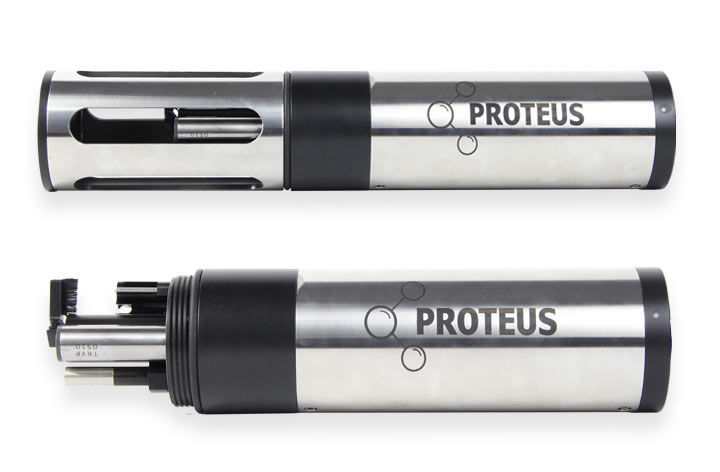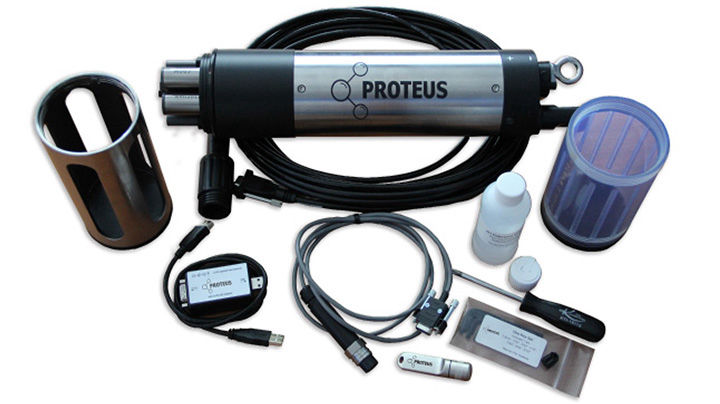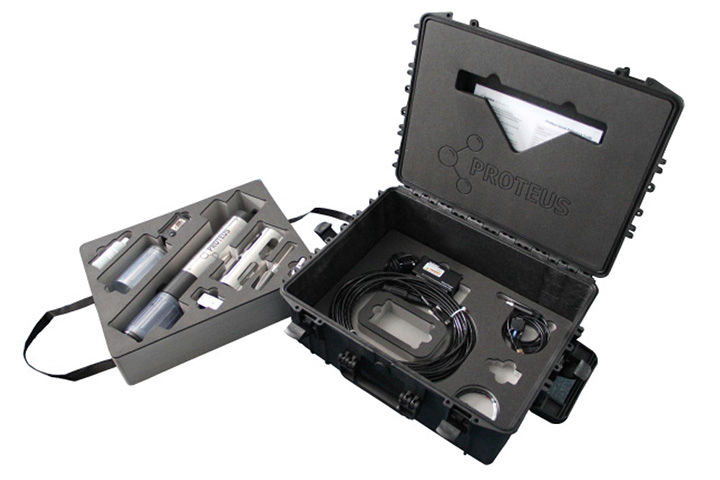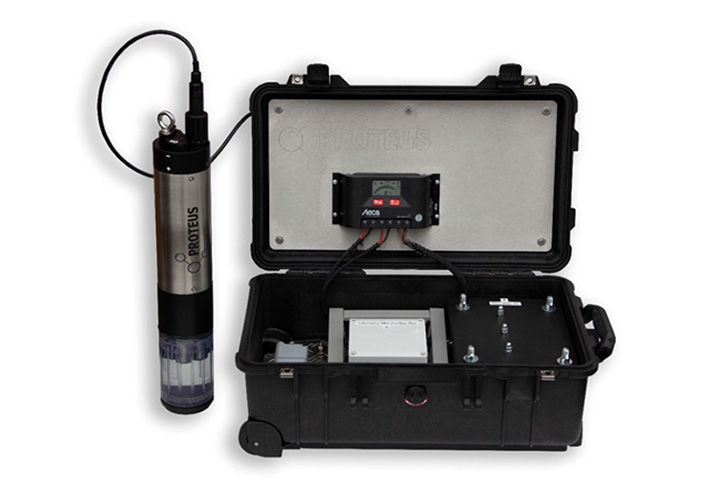

For your choice of parameters
Proteus is the first instrument to measure bacteria/coliforms in drinking water in real-time

Built in wiper which cleans sensors before every cycle
Easily integrated with telemetry/SCADA systems and other data logging devices
Parameters include:
A range of power options are available including internal lithium battery packs, ideal for unattended logging, or multiple external power options of battery, mains or solar panel.

Applications:
Specifications:
General Specifications - Proteus 30
Diameter: 2.95"
Length - w/o Battery Pack: 19"
Weight - with IBP: 5.0 lbs
Number of Sensors: Up to 7
Optional Battery Pack: 8 “C” cells
General Specifications - Proteus 35
Diameter: 3.5"
Length - w/o Battery Pack: 19"
Weight - with IBP: 9.0 lbs
Number of Sensors: Up to 11
Optional Battery Pack: 8 “C” cells
General Specifications - Proteus 40
Diameter: 4.00”
Length - w/o Battery Pack: 19"
Weight - with IBP: 10.0 lbs
Number of Sensors: Up to 13
Optional Battery Pack: 8 “C” cells
General Specifications All Versions
Internal Power Battery Life: 1 to 24 month depending on sensors / logging rates
Eternal Power: 5-15 vdc
Operating Temperature: 32 to 122 °F non-freezing
Depth Rating: 200 m
Communications: RS-232, SDI-12, USB or Bluetooth
Sample Rate: 1 Hz
Data Memory: >1,000,000 logged readings
Logging Rates: 1 second to 1 day
Warranty: 2 years*
* All sensors included except ISE’s (Ammonia/nitrate/chloride)

Typical Proteus Equipment Overview; please note: this varies depending on individual requirements.

The Proteus connects and communicates with your PC using a USB Serial adapter.

Optional Proteus Transport case

An example of a Proteus set-up using solar power and transmitting data via to the outpost cloud server.
BOD is an abbreviation for Biochemical Oxygen Demand. This is the English abbreviation, it is also shortened to DBO which is the short for Demanda Biológica de Oxigênio. BOD represents the amount of dissolved oxygen consumed during the decomposition of organic matter by aerobic organisms in water systems.
COD is an abbreviation for Chemical Oxygen Demand. COD is an indicative measure of the capacity of a water system to absorb oxygen during organic matter decomposition and the oxidation of soluble, inorganic compounds such as Ammonia and Nitrite. DCO also means the same it is just the abbreviation of Demande Chimique en Oxygène, so is abbreviated differently to the English version.
Total dissolved solids (TDS) is a measure of the combined inorganic and organic substances dissolved in water. It is directly related to the electrical conductivity of water and as such can be used as an indication of change. TDS is only relevant in freshwater systems as salinity will dramatically increase the conductivity and therefore apparent TDS.
TSS is a custom parameter which we achieve through a specific calibration and algorithm applied to the turbidity sensor. We can accommodate custom particle sizes if a sample or reference is provided.
All our sensors come with a standard 24-month warranty and there is also the option to purchase an extended warranty
As each unit is a bespoke construction based on the client’s requirements, there is no “average” cost of the Proteus. Sensors are priced individually and depending on the parameters required depends on the sensor set-up that will be used. The best way to get an idea of a quote is to contact us via the inquiry form.
Cost of ownership is negligible due to the advanced technology and high specification we manufacture each unit to. They are completely re-agentless and require only periodic calibration (6-12 months on average) and cleaning, which is further reduced in frequency by the novel self-cleaning system (dependent on environmental factors). As such, they require no special expertise or equipment to maintain and the cost is relatively low, particularly in comparison to other ‘in-situ’ sensor systems.
No. The Proteus utilizes cutting edge fluorescence technology which is completely without reagent or manipulation to the environment it is entered into.
Very few as the Proteus is designed to be efficient and low maintenance. We advise purchasing spare wiper brushes, which generally are replaced every 6-12 months. In addition, you may require to purchase some calibration fluids every 12 months, however this is not a requirement for all sensors.
None, the Proteus is a small and compact system which is easy to install, no matter what environment it is being placed into or whether the set-up is permanent or for spot-measurements. The Proteus is highly adaptable in that it does not require specialised buildings or kiosks as it can be deployed directly into water sources such as reservoirs and rivers. We also have extensive experience of installing using stilling wells and other set-ups which can be more suited to WWTWs and other water infrastructure. We have a dedicated team of experienced engineers who can work with you to devise the best installation of your Proteus.
The only similarity between the two is that they both engage with the UV portion of the EM spectrum however that is where the comparisons end. Where UV-Vis focuses on the absorption of UV and visible wavelengths, Proteus’ optical sensors utilises the intrinsic fluorescence of organic matter through fluorescence spectroscopy. Known substances, such as the amino acid Tryptophan, fluoresce at particular UV wavelengths when excited by UV light. This knowledge has been used to develop cutting edge sensors and algorithms to quantify TLF, CDOM, BOD, total coliforms and more; bringing the Proteus to the forefront of water quality technology.
Watch our video on how to calibrate tryptophan below
Download!